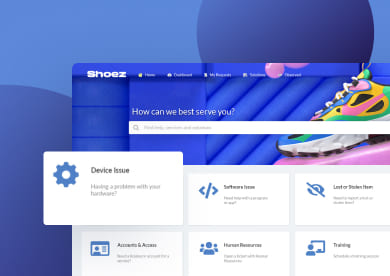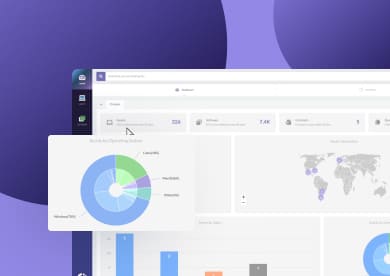Keeping your IT infrastructure organized and functioning well requires several systems, and hardware tracking is one of them.
Managing the location, condition, and lifecycle of hardware assets like computers, servers, and networking equipment can be challenging. Organizations often face unexpected costs, underutilized resources, and compliance issues without proper tracking.
In this article, we'll explore best practices for hardware tracking, explain how to implement an effective solution, and examine the benefits of using a specialized tool like InvGate Asset Management.

Definition and scope of hardware tracking
Hardware tracking (in this context also called IT hardware tracking) refers to the process of monitoring the physical assets within your IT infrastructure.
This includes keeping tabs on the location, user assignment, status, and lifecycle of all hardware devices like computers, printers, servers, and more. But it's so much more than that. It ensures that assets are being utilized effectively, minimize the risk of loss, and help IT identify potential issues before they escalate.
If you want to dive deeper into the topic, we wrote a Hardware Asset Management guide that covers hardware tracking and many best practices for managing your physical assets.
Hardware tracking vs hardware inventory vs IT Asset Management
Hardware tracking, hardware inventory, and IT Asset Management are closely connected, but they operate at different levels.
Hardware inventory focuses on identifying and listing physical devices. Hardware tracking builds on that inventory by monitoring how those devices are assigned, used, and managed over time. ITAM sits at a higher level, combining tracking data with policies, financial controls, and lifecycle strategies to optimize asset value and reduce risk.
What does hardware tracking include?
Hardware tracking covers the ongoing monitoring and management of physical equipment across its lifecycle. While it includes inventory data, it extends further by adding operational and usage context, such as:
- End-user devices like desktops, laptops, and mobile devices.
- Infrastructure hardware such as servers, networking equipment, and storage.
- Peripherals including printers, monitors, keyboards, and other accessories.
- Asset location and movement.
- User assignment and responsibility.
- Usage history and status changes.
- Depreciation and lifecycle stages.
Why hardware tracking matters
Hardware tracking matters because it gives organizations visibility into the location, status, and usage of physical assets, helping them prevent loss and ensure accountability.
By implementing hardware asset tracking, companies can reduce downtime, streamline maintenance, and optimize their IT investments.
Benefits for cost control, security, and compliance
Tracking your hardware is more than just knowing where devices are. It offers several essential advantages that directly impact your organization's efficiency, security, and financial health.
- Visibility and control: As businesses grow, so does the complexity of managing hardware and knowing the status and location of every asset. Tracking hardware lets you know where every asset is, who’s using it, and whether it’s still needed — preventing loss and improving accountability. It helps detect anomalies like unauthorized moves or usage.
- Reducing unnecessary costs: With real-time data on asset utilization, you can avoid redundant purchases, extend the life of underused equipment, and forecast refresh cycles more accurately.
- Compliance and data security: Regulated industries need audit trails. Hardware tracking helps meet those requirements and quickly respond to lost or stolen devices. Maintaining a verifiable hardware inventory is essential for compliance frameworks. It also helps identify unaccounted-for devices that may pose a security risk.
- Minimizing operational disruptions: When you can monitor hardware health and status, it’s easier to plan maintenance and avoid downtime from unexpected failures.
- Improving lifecycle planning: Hardware has a limited lifespan, and it is essential to track the hardware lifecycle of each device — from acquisition to decommissioning. A good tracking system helps manage warranties, handle asset depreciation, and plan for end-of-life disposal, ensuring that you’re maximizing the value of your IT investments.
How hardware tracking works
There are two key components to doing hardware inventory tracking right: using the right technology and following a clear, repeatable process. Let’s take a closer look at both to understand how organizations can track their physical IT assets accurately and efficiently.
IT hardware tracking technologies
Different technologies can support and enhance your IT hardware tracking efforts by improving accuracy, saving time, and enabling automation. Here are the most commonly hardware tracking technologies:
- QR codes – Affordable and easy to implement, QR codes allow users to scan assets with a mobile device to view or update inventory details in real time.
- Barcodes – A traditional and reliable method for tracking hardware, especially when integrated with handheld scanners or mobile apps.
- RFID (Radio-Frequency Identification) – Uses radio waves to automatically identify and track tagged hardware without direct line-of-sight. Ideal for high-volume environments.
- Bluetooth Low Energy (BLE) – Enables real-time tracking of assets within a specific range. Great for monitoring hardware across office spaces or campuses.
- GPS – Provides location tracking for assets that are mobile or deployed across multiple sites. Commonly used for field equipment or transportable devices.
- NFC (Near Field Communication) – Useful for short-range tracking and asset verification, typically via smartphones or dedicated readers.
- Hardware tracking software with IT asset discovery capabilities – Some advanced platforms include network scanning to automatically detect and log connected devices, making it easier to maintain a complete and current inventory.
IT hardware tracking process
To perform hardware inventory tracking effectively, companies need a clear process that ensures physical assets are recorded, updated, and monitored throughout their lifecycle. Here’s how to do it right:
- Build a centralized asset inventory - Start by gathering key information for each device — such as type, serial number, location, assigned user, and purchase details. While this can be done manually, moving to a dedicated hardware tracking system early on helps avoid errors and saves time.
- Tag physical assets for identification - Label each item with asset tags like QR codes or barcodes to make updates easier. This is essential to track computer hardware efficiently and is the foundation of any IT hardware tracking process.
- Set up consistent tracking routines - Define when and how asset data should be updated — for instance, during onboarding, maintenance, or decommissioning. Assign roles and responsibilities to make sure no update slips through the cracks.
- Leverage hardware tracking software - As your inventory grows, spreadsheets won’t cut it. Hardware asset tracking tools automate key tasks, centralize data, and offer real-time visibility. Many also integrate with Service Management platforms, making your operations even more efficient.
- Run regular audits and reconciliations - Schedule routine checks to verify that what's in your system matches what's physically on-site. A clean, up-to-date inventory reduces risk, improves compliance, and ensures your hardware tracking system stays reliable.
Using InvGate Asset Management as your hardware tracking software

InvGate Asset Management is a no-code, intuitive, and easy-to-use IT Asset Management solution designed to help organizations gain full control over their hardware assets.
It excels at asset tracking (both hardware and software) by combining automated data collection with flexible manual processes, ensuring you always have an accurate, real-time view of your IT infrastructure.
Here’s how InvGate Asset Management empowers your hardware tracking efforts:
-
Automated agent-based data collection: Deploy agents on networked devices to automatically gather hardware specs, user info, software, and health metrics, reducing manual input and ensuring accurate records.
- Unique asset identification: Tag assets with QR codes for easy tracking, access, and updates.
-
Movement and ownership tracking: Use check-in/check-out workflows with approvals to monitor asset transfers, preventing loss and maintaining accountability.
-
Health monitoring and alerts: Set customizable health rules and automated alerts for issues like high CPU usage or missing device check-ins to enable proactive management.
-
Lifecycle and Depreciation Management: Track asset stages, warranties, maintenance, and expected lifespan to support budgeting and timely replacements.
-
Detailed reporting: Generate reports on usage, condition, age, and maintenance to inform purchasing and resource allocation decisions.
-
Integration with ITSM tools: Connect hardware assets to incidents, changes, and service requests for better IT operations insight. InvGate Asset Management integrates seamlessly with well-known ITSM platforms (including InvGate Service Management) to enhance visibility and streamline workflows.
Discovery and automation
Discovery and automation are at the core of effective hardware tracking. InvGate Asset Management automatically discovers hardware through agents and network discovery, reducing manual work and keeping the inventory accurate and up to date as environments change.
In its latest version, InvGate Asset Management expands these capabilities by automatically detecting one of the most common and requested peripherals: USB-connected printers.
Printers connected to computers reporting with the agent can be identified and incorporated into the inventory automatically, or reviewed and added manually. This gives teams visibility into devices that are often overlooked, helping them understand where printers are connected, who is using them, and how they move across the organization.
InvGate Asset Management is continuing to expand automated discovery to cover additional peripherals, such as monitors and other commonly used devices, further strengthening hardware tracking with minimal manual effort.
4 best practices to track hardware
To implement hardware tracking effectively, it's important to follow best practices that cover everything from data collection to lifecycle management. Here are 4 hardware tracking best practices to consider:
- Centralize data in one system: A centralized system ensures that all stakeholders have access to up-to-date information, which reduces the risk of errors and allows for better decision-making.
- Automate wherever possible: Manually tracking hardware can lead to errors and wasted time. Automation tools can help reduce the burden on your IT team by automatically collecting data on hardware status, usage, and location.
- Conduct regular audits: Even with a good tracking system, it's important to audit your hardware inventory periodically. Audits help you ensure that assets are where they’re supposed to be and are being used as intended.
-
Prepare to scale: Spreadsheets don’t scale well when managing hundreds or thousands of assets. Implement a specialized tool as soon as possible to effortlessly accommodate a growing inventory and ensure that your tracking system remains effective as the organization grows.
Conclusion
Hardware tracking is essential for any organization looking to optimize its IT operations.
While spreadsheets may have been a common solution in the past, they simply can't match the accuracy, automation, and scalability offered by dedicated hardware tracking tools. Implementing a robust system empowers your team with the insights and control needed to make strategic IT decisions.
InvGate Asset Management can be the solution you need. Request a 30-day free trial and see for yourself! Remember that all the data you include at this stage can later be turned into your working instance.















